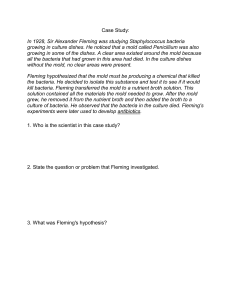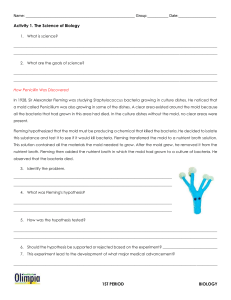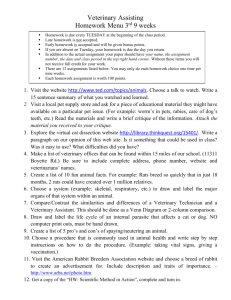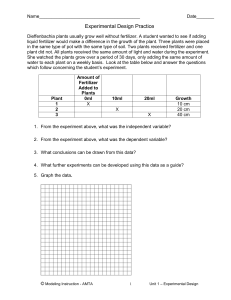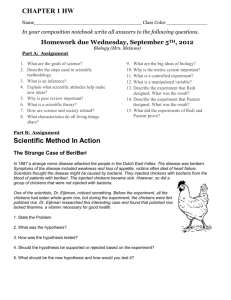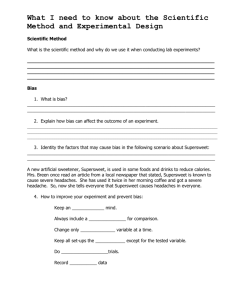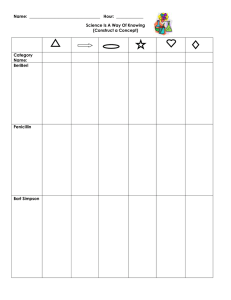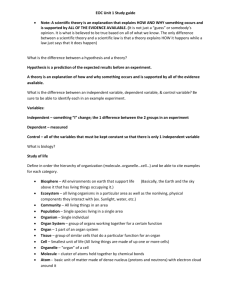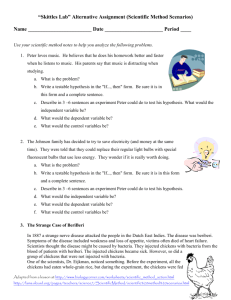Fall Final Review 2015 - Pre-AP
advertisement
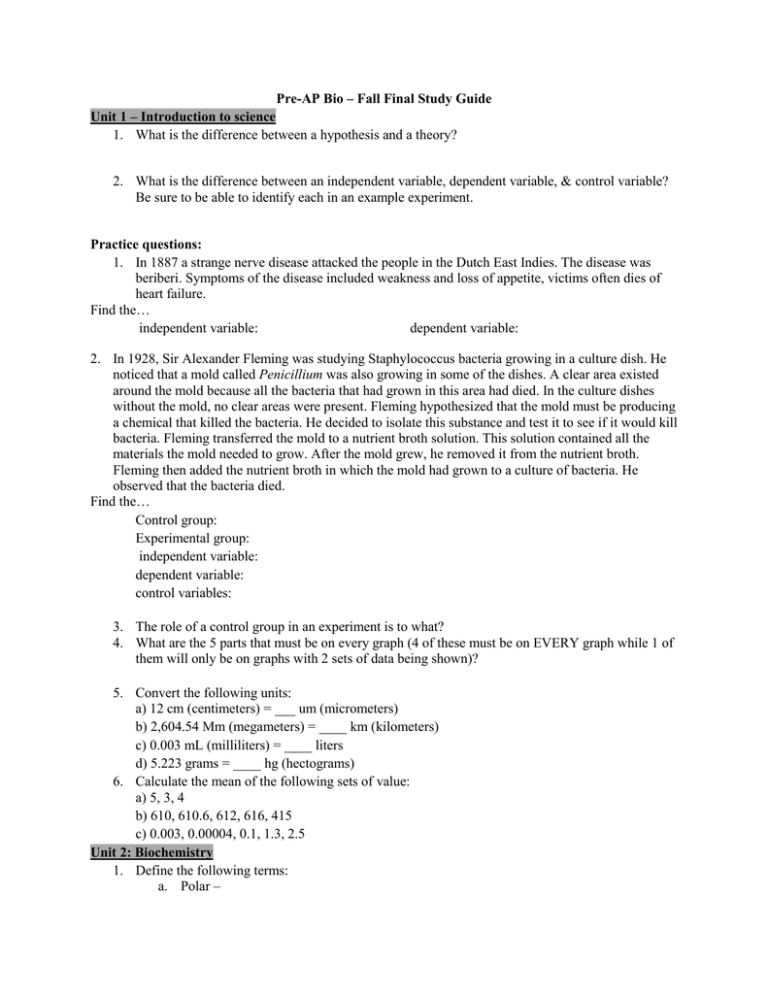
Pre-AP Bio – Fall Final Study Guide Unit 1 – Introduction to science 1. What is the difference between a hypothesis and a theory? 2. What is the difference between an independent variable, dependent variable, & control variable? Be sure to be able to identify each in an example experiment. Practice questions: 1. In 1887 a strange nerve disease attacked the people in the Dutch East Indies. The disease was beriberi. Symptoms of the disease included weakness and loss of appetite, victims often dies of heart failure. Find the… independent variable: dependent variable: 2. In 1928, Sir Alexander Fleming was studying Staphylococcus bacteria growing in a culture dish. He noticed that a mold called Penicillium was also growing in some of the dishes. A clear area existed around the mold because all the bacteria that had grown in this area had died. In the culture dishes without the mold, no clear areas were present. Fleming hypothesized that the mold must be producing a chemical that killed the bacteria. He decided to isolate this substance and test it to see if it would kill bacteria. Fleming transferred the mold to a nutrient broth solution. This solution contained all the materials the mold needed to grow. After the mold grew, he removed it from the nutrient broth. Fleming then added the nutrient broth in which the mold had grown to a culture of bacteria. He observed that the bacteria died. Find the… Control group: Experimental group: independent variable: dependent variable: control variables: 3. The role of a control group in an experiment is to what? 4. What are the 5 parts that must be on every graph (4 of these must be on EVERY graph while 1 of them will only be on graphs with 2 sets of data being shown)? 5. Convert the following units: a) 12 cm (centimeters) = ___ um (micrometers) b) 2,604.54 Mm (megameters) = ____ km (kilometers) c) 0.003 mL (milliliters) = ____ liters d) 5.223 grams = ____ hg (hectograms) 6. Calculate the mean of the following sets of value: a) 5, 3, 4 b) 610, 610.6, 612, 616, 415 c) 0.003, 0.00004, 0.1, 1.3, 2.5 Unit 2: Biochemistry 1. Define the following terms: a. Polar – b. Nonpolar – c. Isotope – d. Ion – e. Atomic number – f. Mass number - g. Ionic bond – h. Covalent bond – i. Hydrogen bond – 2. Acids / Bases: a. Draw and label the range of the pH scale, label the acidic, neutral, and basic regions? b. What happens to the hydrogen ion concentration in a solution if it goes from a pH of 1 to pH of 4? 3. Water: a. What is surface tension, and what makes it possible? b. What is cohesion? c. What is adhesion? d. What is capillary action? 4. Organic compounds: a. What is a monomer? b. What is a polymer? c. What process is used to create bonds between monomers, and how does it work? d. What process is used to break the bonds of a polymer, and how does it work? 5. All organic molecules contain what element? 6. Carbohydrates: a. What 3 elements do all carbohydrates have? b. What ratio do these 3 elements occur in for carbohydrates? c. What is the monomer for carbohydrates? d. List 1 example of monosaccharides, and where they are found in life. e. List 1 example of disaccharides, and where they are found in life. f. List 1 examples of polysaccharides, and where they are found in life. g. What is a polysaccharide that is un-digestible by humans (and therefore is not used for energy)? 7. Proteins: a. What is the monomer of proteins? b. What type of bond is between amino acids? c. What two functional groups are found in amino acids? 8. Lipids: a. List 2 examples of lipids, and explain their function in life. b. Which one is saturated? 9. Nucleic Acids: a. What is the monomer of a nucleic acid? b. What are the 3 parts of a nucleotide? Unit 3: Cell Structure and Transport 1. What are the functions of the following organelles: a. Lysosome b. Smooth and Rough ER c. Ribosomes d. Peroxisomes e. Nucleus f. Golgi Body g. Mitochondria h. Chloroplast 3. How are mitochondria different from chloroplasts? a. Do plants have mitochondria, chloroplasts, or both. Why? 4. What is the nucleolus? 5. What are the 3 types of fiber that makes up the cytoskeleton? Which is the biggest and smallest? 6. List 3 differences between prokaryotic and eukaryotic cells. 7. How is a cell wall different from a cell membrane (plasma membrane)? 8. What type of cell has a cell membrane, what about cell wall? 9. What are 3 organelles found in a plant cell and not an animal cell? 10. Explain the movement of water if a cell were placed in a… Hypertonic – Hypotonic – Isotonic – 11. What type of solutions do plant & animal cells prefer? 12. If an animal cell swells too much, it will what? What prevents a plant cell from doing this? 13. List 2 differences between active & passive transport, and provide 3 examples of each. 14. What is “concentration gradient” and what is going “down or with” it and going “against it”? 15. How is active transport like facilitated diffusion? 16. How is facilitated diffusion different from diffusion? 17. What does selective permeability mean? 18. If solution A has a higher concentration of solute than solution B, which direction will the water flow during osmosis? Unit 4: Bioenergetics 1. Enzymes: a. Define: i. Solute – ii. Active Site – iii. Denature – b. How do enzymes affect the reaction rate? c. What is activation energy? d. How does an enzyme affect activation energy? e. In the diagram above, which is the activation energy with and enzyme? (A or B) Reaction A requires (more or less) energy than reaction B? f. List 4 factors that can affect the rate of a reaction. g. Describe two types of inhibitors, how are they different? 2. Photosynthesis: a. Draw a chloroplast and label the following: a) stroma, b)granum, c) thylakoid, d) thylakoid space b. What is the balanced equation for photosynthesis (Draw arrows between the reactants and products to show what product each reactant becomes)? c. What are the 2 stages of photosynthesis? d. Explain in detail the following for each stage listed above: a) where the stage occurs, b) What are the reactants and products of each stage, c) what is the “purpose” of each stage e. What is the the purpose of NADPH? 3. Cell Respiration: a. Which of the following make ATP for energy: prokaryotes, plants, animals? b. Explain your answer for #1. c. Which of the following USE MITOCHONDRIA to make ATP: prokaryotes, plants, animals? d. Explain your answer for #3. e. What is the balanced equation for cellular respiration (Draw arrows between the reactants and products to show what product each reactant becomes – Remember to look for the flow of hydrogens)? f. Draw a mitochondria and label the following: a) outer membrane, b) inner membrane, c) intermembrane space, d) cristae, e) mitochondrial matrix g. h. i. j. What are the 3 stages of cellular respiration? Which of these 3 stages produces ATP? Which of the 3 stages produces the most ATP? Describe in detail what occurs during all 3 phases. Be sure to include a) where the stage occurs, b) What are the reactants and products of each stage, c) what is the “purpose” of each stage k. Oxidative phosphorylation involves the electron transport chain and chemiosmosis. Describe these 2 processes, and how they work together to produce ATP. l. All of the following questions concern fermentation. a. What is it? b. Where does it occur? c. Why do it? (Pros / Cons) d. What organisms can do it? e. Which organisms do Alcohol Fermentation? f. Which organisms do Lactic Acid Fermentation? Unit 5: Cell Cycle and Signaling 1. Define the following terms. a. Sister chromatids b. Centromere c. Somatic cell d. Homologous chromosomes e. Gametes f. Zygote g. Autosomes h. Sex chromosomes i. Crossing over Questions: 1. Draw a eukaryotic chromosome and label the following: DNA, gene, chromatid, centromere. 2. Name 3 reasons why a cell would undergo mitosis. 3. What type of cells does mitosis produce? What type of cells does meiosis produce? 4. Describe what occurs in each of the 3 phases of interphase. (Gap 1, Synthesis, and Gap 2) 5. We talked about 5 stages involved in the cell cycle (interphase then mitosis – PMAT). List those 5 stages in order and describe what occurs during each of these stages. 6. During what stage(s) of the cell cycle is DNA in chromatin form? When is it in chromosome form? (Interphase and Mitosis) 7. How are chromatin and chromosomes different? 8. What are cells that are not a sperm or egg called? What are chromosomes not involved in determining sex of an organism called?
